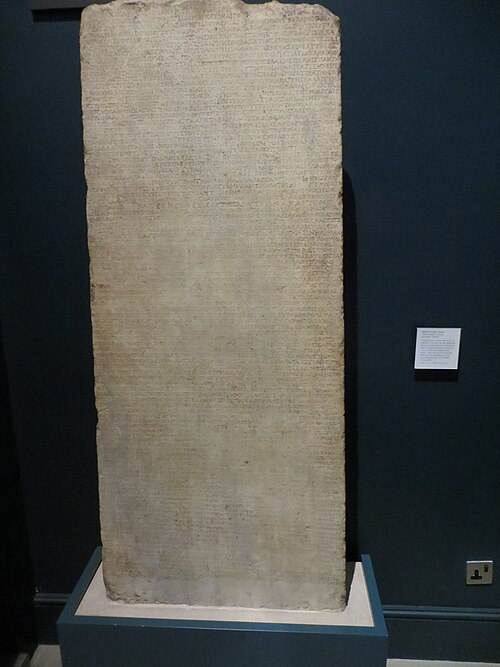Σηστός(in Ancient Greek) | |
 | |
| Location | Akbaş Kalesi,Çanakkale Province,Turkey |
|---|---|
| Region | Thrace |
| Coordinates | 40°13′58″N26°25′21″E / 40.23278°N 26.42250°E /40.23278; 26.42250 |
| Type | Settlement |
| History | |
| Founded | c. 600 BC |
| Site notes | |
| Public access | Restricted |
Sestos (Greek:Σηστός,Latin:Sestus) was an ancient city inThrace. It was located at theThracian Chersonese peninsula on the European coast of theHellespont, opposite the ancient city ofAbydos, and near the town ofEceabat inTurkey.
InGreek mythology, Sestos is presented in the myth ofHero and Leander as the home of Hero.[1]

Sestos is first mentioned inHomer'sIliad as aThracian settlement,[2] and was allied withTroy during theTrojan War.[3] The city was settled by colonists fromLesbos in c. 600 BC.[4] In c. 512, Sestos was occupied by theAchaemenid Empire,[5] andDarius I ferried across from the city to Asia Minor after hisScythian campaign.[4] AlongsideByzantium, Sestos was considered to be one of the foremost Achaemenid ports on the European coast of theBosphorus and theHellespont.[6] In 480, at the onset of theSecond Persian invasion of Greece,Xerxes Ibridged the Hellespont near Sestos.[4]
In 479 BC, after the Greek victory at theBattle of Mycale,[6] Sestos was besieged byAthenian forces led byXanthippus.[7] The Greek siege was resisted by a joint force of Persian soldiers and the city's native inhabitants and endured the whole winter, however, food supplies were inadequate as the siege was unexpected, and the city's garrison suffered from famine.[7] The garrison subsequently capitulated and the Persian soldiers were imprisoned.[7]Artayctes, the Persian governor of Sestos, had escaped, but was captured and crucified.[8] However, Athenian influence over Sestos lapsed briefly, according toPlutarch, asCimon retook the city in a second campaign at some point between 478 and 471.[9]
Sestos became a member of the Athenian-ledDelian League, and was part of theHellespontine district.[10] The city contributed aphoros of 500drachmas annually from 446/445 to 435/434, after which Sestos provided 1000 drachmas until 421/420.[10] At Sestos, a 10 per cent tax was levied on westbound, non-Athenian, merchant grain ships.[1] The city served as a base for the Athenian fleet until it was occupied bySpartan forces led byLysander in 404, during thePeloponnesian War.[10] Sestos' population was briefly expelled and replaced by Spartan settlers, but the city's native inhabitants were permitted to return to the city soon after.[10]
During theCorinthian War, Sestos was occupied by Athenian forces led byConon in 393, and the city came under the control ofAriobarzanes, Satrap ofPhrygia.[10] In 365, an attack on Sestos byCotys I, King ofThrace, was repelled with the aid ofTimotheus, for which Athens was awarded with Sestos andKrithotai in the same year.[10] Acleruchy was established at Sestos in 364,[11] but the city was conquered by Cotys I after a surprise attack in 360, and a Thracian garrison was established.[12] The Athenian generalChares seized Sestos in 353 and carried outandrapodismos whereby the male population was killed and women and children were enslaved; the city was repopulated by Athenian cleruchs.[10]

Sestos remained under Athenian control until thePeace of 337 and dissolution of theSecond Athenian League, after which Sestos joined theMacedonian-ledLeague of Corinth.[13]Alexander the Great, King of Macedonia, crossed over from Sestos to Asia Minor in 334 BC.[5] After the death of Alexander the Great in 323, the city, alongside other Macedonian dependencies in Thrace, was allocated toLysimachus as a result of thePartition of Babylon.[14] The mint of Sestos was established in c. 300 BC.[10] Lysimachus retained control of the city until his death at thebattle of Corupedium in 281.[15]
The city was seized byPhilip V, King of Macedonia, in 200 BC,[16] and remained under Macedonian control until the conclusion of theSecond Macedonian War in 196 with the Peace of Flamininus, which proclaimed Sestos a free city.[17] In 196 BC, during theRoman–Seleucid War, Sestos surrendered toAntiochus III,Megas Basileus of theSeleucid Empire, who refortified the city in 191 in preparation for a Roman attack, only for the city to surrender toGaius Livius Salinator in 190.[18] At the end of the war, theTreaty of Apamea of 188 awarded Sestos to theKingdom of Pergamon.[19] By the end of the Hellenistic period, the offices ofgymnasiarch and ofephebarch, with responsibility for theneoi (young) andepheboi (adolescents), are attested at Sestos.[20][21]
Upon the death ofAttalus III, King of Pergamon, in 133 BC, Sestos was annexed to theRoman Republic afterAristonicus, a pretender to the throne, had been defeated.[22] The city was mentioned inPtolemy'sCanon Urbium Insignium.[23] The mint of Sestos ceased to function in c. 250 AD.[24] It is believed that Sestos, with Abydos andLampsacus, is referred to as one of the "three large capital cities" of the Roman Empire inWeilüe, a 3rd-century AD Chinese text.[25]Gaius Julius Solinus inCollectanea rerum memorabilium also makes reference to the city.[26]
Bylate antiquity, the harbour of Sestos had silted up.[27] In 447 AD, Sestos was sacked by theHuns.[28] The city was damaged by an earthquake during the reign of EmperorZeno in 478 AD.[29] In the 6th century, according toProcopius'De Aedificiis, EmperorJustinian I refortified Sestos.[4]
It is believed that Sestos is referred to as Ṣāṣah in theBook of Curiosities of the Sciences and Marvels for the Eyes, an 11th-century Arabic treatise.[30] By the 13th century AD, the crossing from Lampsacus toKallipolis had become more common and largely replaced the crossing from Sestos to Abydos.[31] The fortress on the site of Sestos was later named Choiridokastron (pig castle), and was captured byOttoman Turks led bySüleyman Pasha in 1355.[32] According toEnveri'sDusturname, Choiridokastron was the first settlement in Europe to be conquered by the Ottoman Turks, whereasAşıkpaşazade recorded that the fortress was attacked by Ottoman forces, after the fall ofTzympe.[33]
 Media related toSestos at Wikimedia Commons
Media related toSestos at Wikimedia Commons